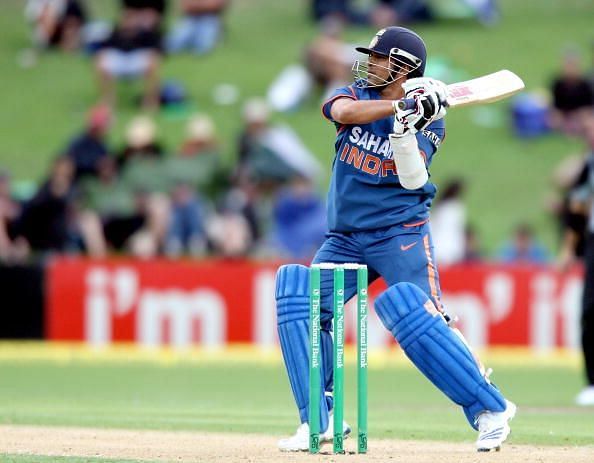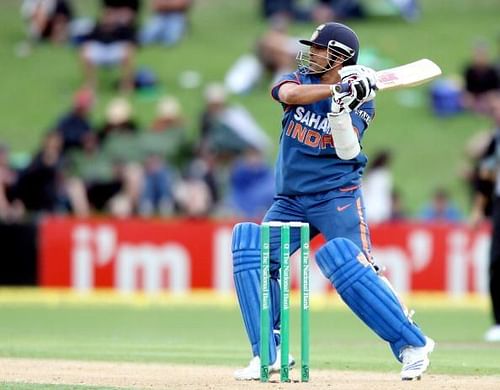
Reminiscing Sachin's 163* in NZ, the first glimpse into the new possibilities of ODI batting

The year was 2009, almost 20 years after his international debut. Sachin Tendulkar was possibly on his last trip to the land of the Kiwis as an active cricketer and he had a few records to set straight.
Quite unusually for a cricketing great who had built his legend around his ability to adapt and play in any kind of condition or situation, NZ proved to be a strange case. The very same batsman who by now had practically owned every batting record there is, had not owned this one nation. He did average a respectable 38+ by human terms, but math and the game of numbers played on papers were for lesser mortals of-course, Tendulkar was God. And the God of cricket had to own this unexplored avenue.
Tendulkar did have his moments, times when it seemed there could be nothing that could stop him from accomplishing what he desired. But fate wouldn't let it be. In 1994, a young Tendulkar, walked out to open the innings for the first time. Chasing a target of 149 to win in 50 overs, Sachin would finish with 82 in 49 balls.
And later at a time that pundits consider as the peak of his prowess in 2002-03, Sachin would twist his ankle and subsequently have a start-stop series. But the fact remained that arguably the greatest batsman to have ever played the game did not have an ODI century in New Zealand.
By 2009, the world knew a Tendulkar hundred all so well. He had after all done that so very often. It would usually come with a single, a well calculated, risk-free one, as Sachin would jog his way across the pitch to the non-strikers end. The crowd and his team mates would be up on their feet, some would bow, the helmet would come off. The helmet in his left, the raised bat in his right as would acknowledge and soak in the applause, and then the head would tilt upwards, towards the sky. Always. But could he do it once? Just once in this unconquered land?
On the tour, as expected, Sachin sat out of the T20 leg. And as the ODI series started, Sachin has had his time to settle into his groove. But he would start slow. In the opening ODI, he would play under the shadows of his explosive, ruthless opening partner, Virender Sehwag. Tendulkar would fall after scoring 20(23). The innings had seen him grow in confidence but the result was not there.
The 2nd match would be washed out by rain, though not before Sachin scored a solid half century - 61(69). But again there was nothing in the innings that gave away any signs of what was to come. There was nothing exhilarating about the innings.
And then the action moved on to the 3rd ODI at Christchurch.
By this time, even the stand-in New Zealand Brendon McCullum had confessed of New Zealand diverting their major focus towards containing and taking the wicket of Sehwag. He had been after all the enforcer so far.
On that day, New Zealand would dislodge Sehwag pretty early. But Sehwag was a capricious force. He was bound to give you some chances. But not Sachin. He took his time initially. As he gauged the game, the conditions, the pitch, the dimensions of the ground and the skills of the opposition.
As Sehwag fell early for the first time in the series, he would launch a chance-less counter attack. Allowing the incoming Gautam Gambhir to settle in, Tendulkar would then return to a calmer self. But Gambhir would fall soon after. This was the opening that the Kiwis were looking forward to. India would now look to consolidate. New Zealand could run through the overs and that hopefully before India realizes that they are late to step on the accelerator.
But Sachin, again as he almost always was through a career spanning 24 years, was a step ahead of the opposition. India opted for the batting powerplay just after the 20th over of the innings. A previously unheralded move, and they would make the most of it. Tendulkar in the company of Yuvraj Singh scored freely, dealing in boundaries, cutting gaps and executing shots with unmistakable accuracy. Wickets falling at the other end did not deter him anymore.
Or perhaps nothing in the world would. Sachin continued in the same vein, entering the 90s with a maximum and soon bringing up his 100. But the best was yet to come. In a space of 32 deliveries since his 100, Tendulkar raced from 100 to 163.
By then however, the pain off the pulled muscle in his stomach was unbearable. And when Sachin gave in to be retired hurt, the extent of the injury was understandable. Sachin would play no further part in the remaining matches of the series.
He perhaps didn't shock anyone while he was on the field. It was only after an injured Sachin left the ground that even the Kiwis realized what had transpired. And just like that with the snap of a finger, the ground would awaken.
He was a wizard who had enchanted the opposition such that they would not know what was hitting them. He was a surgeon who had cut through the veins of the opposition with precision. They would bleed. But with all the action around they would not realize it before it was too late.
This day in 2009 it was not Tendulkar, the boy wonder, scoring runs. There was no display of ruthless, audacious shots that left the world gaping. He was not the diamond that India had unearthed that fine day in 1994, when Tendulkar first opened the innings. Today, he was the batting maestro, the cricketing God. Slower instincts and body ridden with injuries would not hold him down. And this day was the perfect testament to it.
Sachin Tendulkar had this elusive territory under his grasp now. And he had captured it not behind the veils of ink and paper, but in a war that was waged on the field. In hindsight, what he also demonstrated that day were the new possibilities on ODI cricket.
After the match McCullum confessed to have believed that Tendulkar would score the ODI doube hundred that day. And he would back him to achieve it soon. And Tendulkar certainly would. In a world where Tendulkar himself was his only challenger and comparison, he would rewrite yet another record a year later, becoming the first person to ever score a 200 in an ODI.